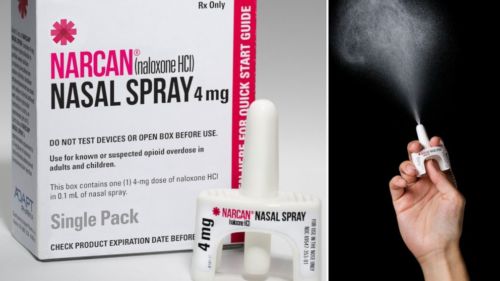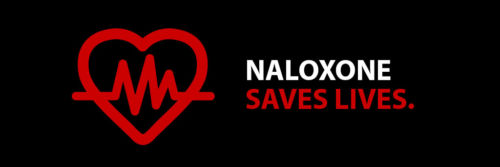Drug Abuse Band-aids May Increase Addictive Behavior
Every action has a reaction and every decision has a consequence. Remember that lesson you learned early in life?
A funny thing happened on the way to introducing naloxone to the world of drug addicts. Experts in the field decided this antidote to near fatal drug overdoses was a near miracle that would save lives and help steer drug abusers back from the brink. Once saved, they opined, the addict could then seek meaningful treatment.
With that endorsement the push was on to try to get every ambulance and law enforcement officer to carry doses of the wonder drug, known most widely by the brand name Narcan. Emergency medical technicians were given vials of naloxone to inject into overdosed addicts. Beat cops got nasal spray doses to administer while they waited for an ambulance. Both proved to be highly successful in bringing addicts back to consciousness.

First Responder Officers Often Have Narcan Nasal Spray For Overdose Victims
Regulation of naloxone varies state to state. In 2010, Quincy, Massachusetts became one of the first to require its police officers to carry naloxone. Earlier this year, New Mexico became the first state to mandate that each and every law enforcement officer be equipped with naloxone. And, nationwide, other states are broadening the public availability of the drug. Today it is not hard for addicts, their friends or family members to get take-home doses – with or without a prescription – at doctor’s offices, pharmacies or community clinics.
Without a doubt, countless thousands have had their lives saved with a dose of Narcan. But then what? Reports from the front lines make it clear: reviving an overdosed patient does not lead them to suddenly seek a sober lifestyle. Furthermore, the widespread availability of this antidote has made many addicts feel invincible.
“We gave Narcan to one particular addict 20 times in one month,” an EMT from a rural upstate New York town told me recently. “And the parents don’t care. They just keep calling us to revive their kid.”

…And Why Isn’t a Life-Saving Epi Pen Free of Charge?
Narcan does seem like a wonder drug. It brings back to life addicts who look lifeless, their lips blue, their breathing nearly undetectable. It works by surrounding opioid receptors in the brain, spine and gut and blocking the effect of narcotics. What the nonchalant drug abuser may not know is that Narcan also causes severe withdrawal symptoms which all but guarantees that a user will be left with a massive desire to quickly find another fix to stop the pain.
In Ohio, where the opioid epidemic led to a record breaking 4,100 + overdoses last year one emergency room doctor openly worries about the increasing use of naloxone.
“It’s such a frustrating problem. We’re saving lives, but it’s only temporary,” Dr. Lisa Deranek said. Repeat overdose patients are common.
“Just throwing Narcan on this opioid fire is not going to fix it (but) I’m afraid the government thinks it is.”
The latest from the National Survey on Drug Use and Health (2014) reports that over 7 million Americans struggle with a drug abuse disorder. The Centers for Disease Control and Prevention reports that more than half a million people died of drug overdoses between 2000 and 2015. This is a complex problem to tackle.
Simply put, Narcan is not the panacea advocates hoped it would be. And for law enforcement it highlights just one more societal problem heaped upon them to have to deal with.
“It’s just reviving somebody who’s going to go back and get high the same day,” said Butler County, Ohio Sheriff Richard Jones. “It’s a war that we’re losing.”
The unsolved problem, of course, is this country’s apparent inability to effectively treat drug addiction.

First Responders: It Also Causes Some Addicts to Overdoes More Often
Interestingly, as the nation’s overdose problem has increased so has the cost of naloxone. In 2014, the price was about $19 a vial. By late 2015 the price of a package of two pre-filled auto-injectors had jumped to $900. By February 2016 that skyrocketed to $4,500. The prescription tracking company IMS Health concludes that naloxone sales have quadrupled in the last few years and now top nearly $81 million.
Think what bona fide drug treatment programs could do with an infusion of $81 million dollars. Rather than spend that much money to slap a temporary band aid on a problem wouldn’t it be smarter to divert at least some of those funds to programs that could help addicts wean themselves back to health? More money would translate to more available treatment beds which all experts agree are sorely lacking.
Decisions have consequences. It’s pretty clear now that sinking tens of millions into a path that doesn’t really reduce the number of addicts in America was more than just a bad idea. It was a mistake.
 ###
###
Reader Gabriel writes:
Re: Drug Abuse Bane-Aids
You nailed it. Good to see some one not bought by Big Pharma. A friend of mine arrived almost dead at the ER. Luckily for him, he found Narconon. The most successful Drug Rehab Program in the world. Did you know about Narconon?
Yes. Its the counter program to AlAnon for recovering alcoholics. When drug abuse treatment beds are not available Narconon is a great alternative – and a great program for life for those in the grip of drugs. Thanks for mentioning this, Gabriel. ~ DD
Reader David Kaufman writes:
Drug Abuse: A War We’re Losing, was a editorial I read in my local paper. I agree 100% with everything you said but I have a problem with the word heroin never being mentioned. I dont have the figures in front of me but I am pretty sure 85-90% of those being treated with Narcan are from Heroin overdoses. This point needs to be made because there are people out there in this world who have been taking prescribed opiates for years and now are being lumped in with the heroin abusers and being shut down by there doctors because of the heroin epidemic. I think the DEA needs to get these numbers out there heroin overdoses compared to prescribed opiate overdoses, as well as the percentages of narcan use with heroin overdoses and the same with prescribed opiate overdoses!
Actually, Narcan can be used for lots of different overdose causes – Methamphetamine, for example. But I think you are correct. Heroin overdoses are probably the most common. Especially these days when deadly fentynal laced heroin is so common.
Thanks for taking the time to write! ~DD
Facebook Friend Alan Fountain writes:
Alan Fountain I am passionate about this topic as I am an advocate for rehabilitation, healing and one has to be alive to heal. We have to move beyond the greed motivations of big Pharma and lobbyist for their needs and put the focus on the patient. Narcan is Important but also court supportive and ordered drug rehab after its administration. I was asked to write a mission statement for a conference in Ohio this past weekend that would help first responders and medical community have greater empathy for rescuing and salvaging the lives of those recklessly abusing Opiods as their morgues and mobile FEMA morgues are over flowing due to overdoses. The reason my input was asked is My Advocacy for Molestation Survivors as they discovered that the common link in all the deaths were that 80% of deceased where victims of youth molestation. The goal of my input was to help Responder Community culture see the innocence in this population due to their chronic abuse of Opiods and it’s link to youth sexual assault. I think we have to dig deeper and include the impetus of crisis in the conversation that is blocked from mainstream narrative due to Catholic Church and Predator Affirming Legislation in our public policy. Great article Diane Dimond but felt I needed to expand on your intelligent insight into the Narcan connection and variable.
Facebook Friend Lenore Riegel writes:
This is fascinating. It shows how important it is to keep striving to understand the psychology and physiology of addiction.
Facebook Friend Paul Nichols writes:
It’s a medical breakthrough, not a moral judgement. I know many people who have had hundreds of thousands worth of life saving medical treatment who then continue destructive drinking and smoking and tragic behavior. What moral police will decide who gets ANY life saving treatment ? After 32 years of sobriety, and as a human being, I’d like to hope we can save the life of an OD victim. The nature of addiction and mental illness does not necessarily mean the victim will stop using. With your argument, we should stop giving chemo to cancer patients who will likely go back out and resume their smoking, drinking, drug using, abusing their bodies lifestyles. Why waste the money ? Your argument is applicable to addicts and cancer patients and transplant patients (who can go out and drink, smoke, do whatever after someone gives them an organ)…and its a slippery slope arguing behavior…
Diane Dimond replies: To be clear, I’m not arguing for any position here. Just stating the facts. And, yes, I agree saving lives is paramount…even if one suspects the patient might engage in destructive behavior again. I just wish our society would put more emphasis on helping addicts beat their demons. So few treatment beds – and still the prevailing attitude of – Well, if they don’t help themselves…. Makes me sad.
Facebook Friend Kenneth R Martin writes:
Narcan is not new. As an EMS provider I have given this drug in the field. When the junkie comes out of it they get very angry because we reversed their high. I think it will lead to more overdoses.
Diane Dimond replies: And first responders have also told me some overdose patients are angry after Narcan because they deliberately wanted to die. Angry that their suicide was thwarted.
Facebook Friend Bill Voinovich writes:
All that is, is an excuse for a junkie to STAY a junkie..
if they know Narcan is gonna be there to pull their butts out of the fire, then they’re STILL gonna OD……..
THEY chose the path they’re going down, and if somebody’s always there to save them, there’s really no consequences to their actions, and they can CONTINUE on doing what they’re doing…..
Sorry, but I think it’s a “junkie crutch”……
Facebook Friend Ginnie Oleskewicz Schwartz writes:
Double edge sword…
Facebook Friend Ronnie Kaminski Latimer writes:
Its true. An addict has to want to save themselves.
Twitter Pal Diplomtc_Immnty@Diplomtc_Immnty writes:
Does one become resistant to Narcan after “x” amount of doses?
Diane Dimond replies:
From what I understand it remains very effective but some EMS tell me that for some hardcore cases its effective only after multiple doses.
Twitter Pal June Hanniman @junehanniman writes:
Sounds to me it made some addicts addicted to Narcan.
ABQ JOURNAL Reader Pat Mallory writes:
I read your article about Narcan in today’s ABQ Journal and I must say it was very informative. I don’t like to think I’m cold-blooded but I truly feel if someone takes an overdose…so be it. Let them go.
Thanks…pat
ABQ JOURNAL Reader Janice Pierson writes:
Dear Diane, Just read your article about Narcan in the ABQ Journal. Thank you for your common sense article about Narcan. You concluded “this antidote has made many addicts feel invincible”. I am no genius but when I first read about tax payer funded Narcan that was my first thought. It’s a no brainer forme. The addict is told, “I can do what I want and I won’t have to suffer the consequences”. I have learned from reading and observation that the greatest lesson children can be taught is to learn to reason to cause and effect. I am a great grand mother, proudly. Please do all you can to promote your ideas.
Janice Pierson
ABQ Journal reader Whitney Buchanan writes:
Diane,
Here’s a colloquy from the excellent movie Traffic:
Robert Wakefield: What are your policies towards treatment of addiction?
General Salazar: Treatment of addiction? Addicts treat themselves. They overdose and then there’s one less to worry about.
The objective of using Narcan isn’t treatment. Not at all. It’s to keep an addict from dying so that the addict might survive long enough to become willing to accept treatment, comply with treatment and recover. Recovery from addiction is an inside job. It only happens when the addict is willing to help himself. Once that happens, recovery is then possible. Even for the worst addict, every passing moment that he’s alive is another chance to make that choice and turn it all around.
The “war” on drugs is a failure. Another quote from the movie:
Robert Wakefield: If there is a war on drugs, then many of our family members are the enemy. And I don’t know how you wage war on your own family.
Many family members become opioid addicts not out of a desire for lawlessness or rebellion against the values we cherish, but from exposure to prescription painkillers. We need to work on developing non-addictive methods of treating pain. We need to stop waging war against the person, and battle the disease. We need to keep our sick family members alive, so that they might have a chance to make that one good decision that allows them to recover and get their lives back. Narcan saves lives. Please don’t oppose saving lives.
Best,
Whitney Buchanan